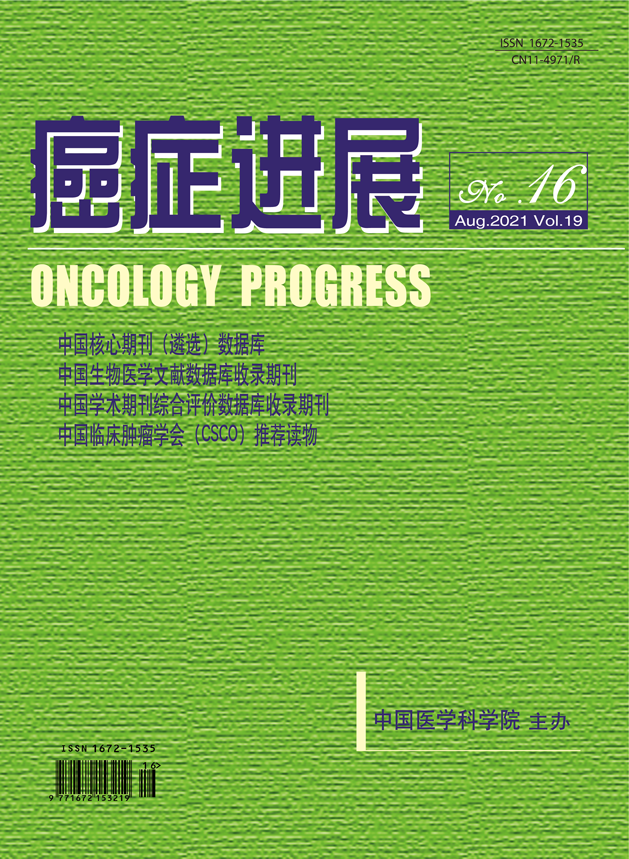杂志信息/Information

- 刊名:癌症进展
- Oncology Progress Journal
- 主管:国家卫生健康委员会
- 主办:中国医学科学院
- 社长:张凌
- 主编:赵平
- 编辑部主任:穆红
- 出版单位:中国协和医科大学出版社有限公司
《癌症进展》编辑部
100730,北京东单三条9号
联系电话:010-57528109
E-mail:azjzzz@163.com
http://www.aizhengjinzhan.com - 印刷:北京联合互通彩色印刷有限公司
- 国内统一连续出版物号:CN 11-4971/R
- 国际标准连续出版物号ISSN 1672-1535
下载专区/Download
订阅电子期刊/Subscribe
提交您的邮箱地址,我们会定期将电子期刊 发送到您的邮箱
期刊检索/Journal Search
扫一扫,关注

2016 年第 3 期 第 14 卷
肾脏上皮样血管平滑肌脂肪瘤的CT及MRI表现
作者:
单位:
- 摘要:
- 【摘要】目的:探讨肾脏上皮样血管平滑肌脂肪瘤的影像学特点,以提高其诊断水平。材料与方法:搜集2005年至2014年经手术病理证实的26例肾脏EAML影像学资料并进行回顾性分析。其中男8例(30.8%),女18例(69.2%);年龄20~61岁,平均年龄41岁。26例患者均未合并结节性硬化症。16例行CT检查,18例行MRI检查。结果:病灶最大径为0.9~16.3cm,平均7.3cm。病灶呈类圆形或类椭圆形20例(77.0%),分叶状4例(15.4%),沿肾周间隙铸型生长1例(3.8%),不规则形1例(3.8%);病灶完全位于肾轮廓之内2例(7.7%),部分突出于肾轮廓外24例(92.3%),其中以窄蒂状与肾实质相连2例(7.7%);2例(7.7%)肿瘤侵犯肾静脉形成静脉瘤栓;1例(3.8%)同时发现腹膜后淋巴结转移;1例(3.8%)同期发现肝脏和肺多发转移。CT平扫示9例(75%)呈高或稍高密度,2例(16.7%)呈等-低或低密度,1例(8.3%)呈等-高密度。MRI平扫T1W图像15例(83.3%)病灶以等信号为主,T2W或T2W/FS图像10例(55.6%)病灶以低信号为主,8例(44.4%)呈低-高、低-等或低-等-高混杂信号。双期增强CT和/或动态MRI增强扫描示25例(100%)均呈不均匀强化,其中10例(40%)呈网格样强化,23例(92.0%)病灶动脉期强化程度呈等或略低于正常肾皮质,实质期强化程度均低于正常肾实质。1例(3.8%)病灶内见弯曲条带状钙化;9例(34.6%)可观察到少量脂肪成分;8例(30.8%)病灶内见扩张或粗大迂曲走行的血管;8例(30.8%)瘤内伴有出血。结论:肾脏EAML影像学表现具有如下特征,女性多见;多呈类圆形或膨胀性生长;肿瘤较大时可出现囊变及出血;病灶内成熟脂肪成分并不多见;钙化罕见;肿瘤实性成分CT平扫呈稍高或高密度;T2WI呈稍低信号或高低混杂信号;动态增强扫描多数呈 “快进快出”的强化特点,不均匀筛网状强化较多见;部分病灶内可见迂曲扩张血管;可以伴有局部淋巴结及远处转移。
- Objective:To retrospectively analyze the MRI and CT features of renal epithelioid angiomyolipoma (EAML). Methods: Between 2005 and 2014, 26 patients (18 women, 8 men) aged 20–61 years (mean 41 years) were surgically and pathologically diagnosed as EAML. None of all the cases had a history of tuberous sclerosis complex. Before operation, 16 patients underwent CT examination, and eighteen patients underwent MRI examination. Results: The diameter of lesions ranged from 0.9 to 16.3 cm (mean, 7.3 cm). 20 lesions appeared as round or oval, four lesions(15.4%) as lobulated, one lesion as restricted growth pattern, and one lesion as irregular. 24 cases(92.3%) showed exophytic masses, and 2 of 24 lesions with narrow pedicles. In addition, two lesions(7.7%) were within kidney contours. In two cases(7.7%), tumor thrombus was seen extending into the right renal vein. One patient(3.8%) had a para-caval lymph nodes involvement. And one patient(3.8%) had liver metastasis and lung metastasis at the?time?of?diagnosis. On pre-contrast CT scans, 9 lesions(75%) appeared as hyperattenuation or slightly hyperattenuation, and two masses(16.7%) as?iso-hypodense or hypodense, and one lesion as iso-hyperattenuation. Compared with the surrounding normal renal parenchyma, 15 tumors(83.3%) presented mainly isointensity on T1-weighted image, and 10 tumors(55.6%) presented mainly hypointensity on T2-weighted image or fat saturated T2-weighted image, and eight of 18 lesions presented iso-hyperintensity, hypo-isointensity, hypo-iso- hyperintensity on T2-weighted image. On contrast CT/MRI scans, 25 lesions(100%) demonstrated inhomogeneous enhancement, and 10 of 25 masses showed reticular enhancement. 23 masses(92.0%) enhanced similar to the normal renal cortex in the corticomedullary phase, and obviously decreased enhancement in the nephrographic phase. Curvilinear?bands?of calcifications was observed in 1 case(3.8%). The tortuous and irregular dilation vessels in the lesion were detected in 8 cases ( 30.8%) and bleeding was found in 8 cases(30.8%). Conclusion: Most of patients with EAML were women. EAML showed round or oval and exophytic mass. The larger mass can be accompanied by necrosis and hemorrhage. Mature fat can be found in some tumors, but not often. Calcification?is?rare. The solid?portion of tumor presented slight hyperattenuation or hyperattenuation in unenhanced CT, hypointensity or hyper-hypointensity mixed signal intensity on T2-weighted images and inhomogeneous enhancement (rapid wash-in and rapid wash-out). Reticular enhancement was more common. The tortuous and irregular dilation vessels were found in some lesions. Some patients had local lymph node involvement and distant metastasis.








